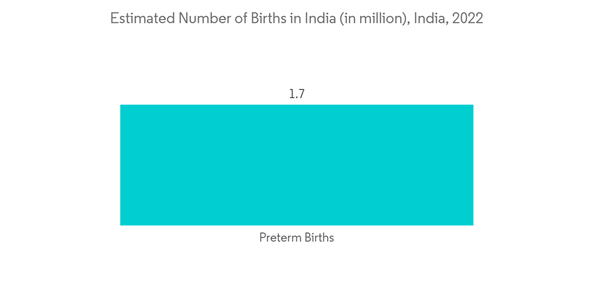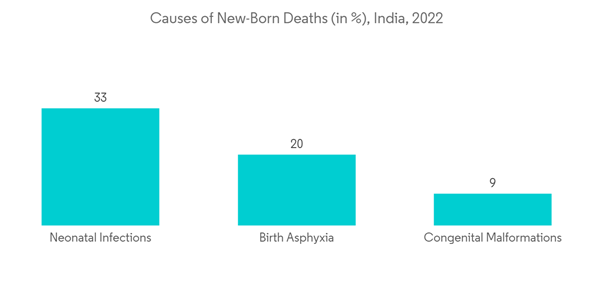India's neonatal and prenatal devices market is expected to register a CAGR of 5.9% over the forecast period.
The COVID-19 pandemic has significantly impacted the Indian neonatal and prenatal devices market. As per the study published by PubMed Central in March 2022, movement restrictions brought on by the lockdown, the lack of public transit, and the concern of contracting Women who have COVID-19 were prevented from using maternal healthcare services. Moreover, as per the study published by PubMed in January 2021, the reduced coverage for all interventions related to mother and child health. The total number of institutional deliveries decreased by 2.26%. The worst-affected services, with a 22.91% reduction, were those for antenatal care. Thus, the COVID-19 pandemic severely affected the market; however, as the pandemic has subsided, the studied market is expected to have stable growth over the forecast period.
The major factors for the growth of the India fetal and neonatal care devices market are increased preterm birth rates, greater public awareness of the importance of prenatal and neonatal care, and government measures to improve care for infants.
Premature babies are born before the mother reaches the gestation period of 37 weeks. Depending on how premature the baby is, certain organs can be underdeveloped, such as the digestive tract, lungs, immune system, and even skin, in certain cases, where the demand for incubators for their survival is inevitable. As per an article published by Times of India in July 2022, the number of premature babies in the region is increasing due to the increasing prevalence of diabetes and obesity among women, along with the rise in multiple births due to fertility treatments. Moreover, as per the United Nations International Children's Emergency Fund (UNICEF) data updated in July 2021, nearly 3.5 million babies in India are born too early, 1.7 million babies are born with congenital disabilities, and one million newborns are discharged each year from Special Newborn Care Units (SNCUs). These newborns remain at high risk of death, stunting, and developmental delay, which will add to the growth of the studied market.
Moreover, UNICEFs focus on equitable reduction of neonatal deaths is in line with the Government of India's 'India Newborn Action Plan,' for which UNICEF is a key partner. The Action Plan aims to significantly reduce preventable newborn deaths and stillbirths and reduce neonatal mortality and stillbirth rate to a 'single digit' by 2030. As thematic technical lead for facility-based newborn care, UNICEF has been instrumental in the scale-up of SNCUs across India and creating one of the biggest real-time online databases for sick newborns globally. UNICEF has also been assigned the role of lead partner in 39 out of 115 aspirational districts in India. With poor indicators across social sectors, these aspirational districts have been identified by NITI Aayog in coordination with line ministries for convergent action.
Thus, all these factors drive the demand for prenatal and neonatal devices across India. However, low birth rates in developed countries, lack of awareness, and economic constraints in many areas are the major factors hindering growth in India's neonatal and prenatal devices.
The companies have various devices on several parameters, among which temperature regulation is very important, as severe temperature differences lead to neonate heat loss, hypothermia, and apnoea, which are closely related to airflow and air velocity. In the emerging markets, the growing focus is being seen on low-cost alternative neonatal incubators, such as MiraCradle and Embrace Nest in India, which are much cheaper than the incubator's original cost, and thus could be more affordable to hospitals and patients in several places across the country. The segment is expected to witness a healthy CAGR over the forecast period. Additionally, the country's increasing birth rate further propels segment growth.
Moreover, per the study published by PubMed in July 2022, 135 (10.86%) of the 1,243 births at the Mediciti Institute of Medical Sciences were premature births. The increasing number of preterm births is further boosting segment growth.
Thus, the segment is expected to witness a high CAGR over the forecast period due to the factors above, such as the increasing number of preterm births and the increasing availability of incubators.
The importance of respiratory assistance and monitoring devices in neonatal care is expected to boost segment growth. For instance, according to an article published by PubMed Central in June 2022, a study was conducted in India which showed that continuous cardiorespiratory monitoring is a vital component of care in preterm neonates, and these devices help in monitoring vital parameters like pulse rate (PR), respiratory rate (RR), and oxygen saturation using pulse oximetry (SPO2) during the hospital stay.
Furthermore, according to the article published by the Indian Journal of Pediatrics in June 2021, respiratory distress is considered a common problem that is seen in neonates, both preterm and full-term neonates. The appropriate use of respiratory assistance devices can be life-saving in these neonates. While invasive ventilation is unavoidable in some situations, noninvasive ventilation may be sufficient in several neonates.
Thus, due to the advantages offered by respiratory assistance and monitoring devices, the studied segment is expected to grow over the forecast period.
This product will be delivered within 2 business days.
The COVID-19 pandemic has significantly impacted the Indian neonatal and prenatal devices market. As per the study published by PubMed Central in March 2022, movement restrictions brought on by the lockdown, the lack of public transit, and the concern of contracting Women who have COVID-19 were prevented from using maternal healthcare services. Moreover, as per the study published by PubMed in January 2021, the reduced coverage for all interventions related to mother and child health. The total number of institutional deliveries decreased by 2.26%. The worst-affected services, with a 22.91% reduction, were those for antenatal care. Thus, the COVID-19 pandemic severely affected the market; however, as the pandemic has subsided, the studied market is expected to have stable growth over the forecast period.
The major factors for the growth of the India fetal and neonatal care devices market are increased preterm birth rates, greater public awareness of the importance of prenatal and neonatal care, and government measures to improve care for infants.
Premature babies are born before the mother reaches the gestation period of 37 weeks. Depending on how premature the baby is, certain organs can be underdeveloped, such as the digestive tract, lungs, immune system, and even skin, in certain cases, where the demand for incubators for their survival is inevitable. As per an article published by Times of India in July 2022, the number of premature babies in the region is increasing due to the increasing prevalence of diabetes and obesity among women, along with the rise in multiple births due to fertility treatments. Moreover, as per the United Nations International Children's Emergency Fund (UNICEF) data updated in July 2021, nearly 3.5 million babies in India are born too early, 1.7 million babies are born with congenital disabilities, and one million newborns are discharged each year from Special Newborn Care Units (SNCUs). These newborns remain at high risk of death, stunting, and developmental delay, which will add to the growth of the studied market.
Moreover, UNICEFs focus on equitable reduction of neonatal deaths is in line with the Government of India's 'India Newborn Action Plan,' for which UNICEF is a key partner. The Action Plan aims to significantly reduce preventable newborn deaths and stillbirths and reduce neonatal mortality and stillbirth rate to a 'single digit' by 2030. As thematic technical lead for facility-based newborn care, UNICEF has been instrumental in the scale-up of SNCUs across India and creating one of the biggest real-time online databases for sick newborns globally. UNICEF has also been assigned the role of lead partner in 39 out of 115 aspirational districts in India. With poor indicators across social sectors, these aspirational districts have been identified by NITI Aayog in coordination with line ministries for convergent action.
Thus, all these factors drive the demand for prenatal and neonatal devices across India. However, low birth rates in developed countries, lack of awareness, and economic constraints in many areas are the major factors hindering growth in India's neonatal and prenatal devices.
India Neonatal & Prenatal Devices Market Trends
Incubators Segment is Expected to have Healthy Growth Over the Forecast Period
Neonatal incubators are often necessary for infants. The infants need respiratory support, ranging from extra oxygen to continuous positive airway pressure (CPAP) or mechanical ventilation. The temperature regulation of infants is among the major factors to be controlled in neonatal incubator cases.The companies have various devices on several parameters, among which temperature regulation is very important, as severe temperature differences lead to neonate heat loss, hypothermia, and apnoea, which are closely related to airflow and air velocity. In the emerging markets, the growing focus is being seen on low-cost alternative neonatal incubators, such as MiraCradle and Embrace Nest in India, which are much cheaper than the incubator's original cost, and thus could be more affordable to hospitals and patients in several places across the country. The segment is expected to witness a healthy CAGR over the forecast period. Additionally, the country's increasing birth rate further propels segment growth.
Moreover, per the study published by PubMed in July 2022, 135 (10.86%) of the 1,243 births at the Mediciti Institute of Medical Sciences were premature births. The increasing number of preterm births is further boosting segment growth.
Thus, the segment is expected to witness a high CAGR over the forecast period due to the factors above, such as the increasing number of preterm births and the increasing availability of incubators.
Respiratory Assistance and Monitoring Devices Segment is Expected to hold a Significant Share Over the Forecast Period
Neonatal respiratory monitoring devices are aimed to support the respiratory system of newborns during critical periods while ensuring any long-term damage to the lungs is limited. The best practice of clinical protocols is recommended for neonatal ventilation which incorporates both lung-protective volume control and CO2 monitoring.The importance of respiratory assistance and monitoring devices in neonatal care is expected to boost segment growth. For instance, according to an article published by PubMed Central in June 2022, a study was conducted in India which showed that continuous cardiorespiratory monitoring is a vital component of care in preterm neonates, and these devices help in monitoring vital parameters like pulse rate (PR), respiratory rate (RR), and oxygen saturation using pulse oximetry (SPO2) during the hospital stay.
Furthermore, according to the article published by the Indian Journal of Pediatrics in June 2021, respiratory distress is considered a common problem that is seen in neonates, both preterm and full-term neonates. The appropriate use of respiratory assistance devices can be life-saving in these neonates. While invasive ventilation is unavoidable in some situations, noninvasive ventilation may be sufficient in several neonates.
Thus, due to the advantages offered by respiratory assistance and monitoring devices, the studied segment is expected to grow over the forecast period.
India Neonatal & Prenatal Devices Market Competitor Analysis
The market studied is fragmented, owing to the presence of various small and large market players. Some market players are Atom Medical Corporation, GE Healthcare, Getinge AB, Koninklijke Philips NV, Masimo, Medtronic PLC, Natus Medical Incorporated, and Phoenix Medical Systems (P) Ltd.Additional benefits of purchasing the report:
- The market estimate (ME) sheet in Excel format
- 3 months of analyst support
This product will be delivered within 2 business days.
Table of Contents
1 INTRODUCTION
4 MARKET DYNAMICS
5 MARKET SEGMENTATION (Market Size by Value - USD million)
6 COMPETITIVE LANDSCAPE
Companies Mentioned (Partial List)
A selection of companies mentioned in this report includes, but is not limited to:
- Atom Medical Corporation
- Becton, Dickinson and Company
- Dragerwerk AG & Co. KGaA
- GE Healthcare
- Koninklijke Philips NV
- Masimo
- Medtronic PLC
- Getinge AB
- Instromedix India
- Narang Medical Limited
- Neonest Medical Systems Pvt Ltd
- Jainco Lab
Methodology

LOADING...










